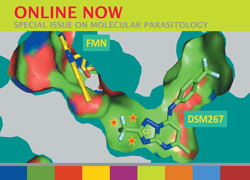data recommended for inclusion in Acta Cryst. F articles
If publBio is used to prepare articles this will help you to include these
recommended data.
Research
communications reporting the crystallization of a biological macromolecule
Include Tables 1, 2 and 3.
Research
communications reporting the structure of a biological macromolecule
Include tables 1, 2, 3 and 4.
|
Table 1
Macromolecule production information
|
In the primers,
indicate any restriction sites, cleavage sites or introduction of additional
residues, e.g. His6-tag, as well as modifications, e.g. Se-Met
instead of Met. |
| Source organism |
| DNA source |
| Forward primer |
| Reverse primer |
| Cloning vector |
| Expression vector |
| Expression host |
| Complete amino acid sequence of the construct produced |
|
| Method |
| Plate type |
| Temperature (K) |
| Protein concentration |
| Buffer composition of protein solution |
| Composition of reservoir solution |
| Volume and ratio of drop |
| Volume of reservoir |
|
|
Table 3
Data collection and processing
|
With values in
parentheses for the highest resolution shell. |
| Diffraction source |
| Wavelength (Å) |
| Temperature (K) |
| Detector |
| Crystal-detector distance (mm) |
| Rotation range per image (°) |
| Total rotation range (°) |
| Exposure time per image (s) |
| Space group |
| a, b, c (Å) |
| α, β, γ (°) |
| Mosaicity (°) |
| Resolution range (Å) |
| Total No. of reflections |
| No. of unique reflections |
| Completeness (%)# |
| Redundancy |
<I/![[sigma]](/logos/entities/sigma_rmgif.gif) (I)> (I)> |
| Rr.i.m.‡ |
| Overall B factor from Wilson plot
(Å2)§ |
#
If completeness <93% or completeness in outer shell <70%, please provide an
explanation [as a footnote here].
†If mean I/σ(I) in outer shell is <2.0, please
provide an explanation [as a footnote here] and provide resolution at which it
falls below 2.0.
‡Only the redundancy-independent merging R factor
Rr.i.m. or Rmeas should be reported. If
these values are not available, they may be estimated by multiplying the
conventional Rmerge value by the factor [N/(N - 1)]1/2, where
N is the data multiplicity [in such cases, provide a footnote
here].
§ State here if
there are any anomalies in the Wilson plot, such as spikes arising from ice
rings, etc.
|
With values in
parentheses for the highest resolution shell. |
| Resolution range (Å) |
| Completeness (%) |
| σ cutoff |
| No. of reflections, working set |
| No. of reflections, test set |
| Final Rcryst |
| Final Rfree |
| Cruickshank DPI |
| No. of non-H atoms |
| Protein |
| Ion |
| Ligand |
| Water |
| Total |
| R.m.s. deviations |
| Bonds (Å) |
| Angles (°) |
| Average B factors (Å2) |
| Protein |
| Ion |
| Ligand |
| Water |
| Ramachandran plot |
| Favoured regions (%) |
| Additionally allowed (%) |
| Outliers (%) |
|
These will typically contain no information about phase determination.
However, if a statement is made which requires the determination of phases,
the relevant statistics, such as the number of heavy-atom sites, phasing
power, estimated phase error etc., in the case of experimental phasing,
and
some combination of initial rigid-body Rwork and
Rfree, the correlation
coefficient, or Z score, in the case of phasing by molecular
replacement,
need to be provided.
Guidelines for publication of NMR data are available from
http://journals.iucr.org/services
/nmr/.
Guidelines for articles reporting structural modelling of small-angle
scattering may be found at http://journals.iucr.org/services
/sas/. For
articles that present experimental SAS data, the deposition of an ASCII file
representing the background-corrected scattering profile(s) with errors is
required.
Authors of structural articles are required to provide a validation report
on
submission. Authors are encouraged to presubmit their data to the wwPDB and
obtain a validation report for their structure. Further information about
validation reports can be found in the online submission instructions at
http://
journals.iucr.org/f/services/submitinstructions.html.


 journal menu
journal menu![[sigma]](/logos/entities/sigma_rmgif.gif) (
(![[publBio]](/logos/publbio.gif)





